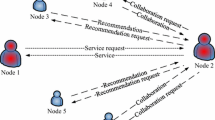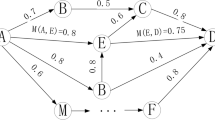Abstract
Aiming at the fuzziness of node trust evaluation and the dynamic evolution of trust decision in spatial information network, a network node trust evolution model based on fuzzy correlation measures is proposed. The model introduces the subjective trust ambiguity of the node, and effectively improves the accuracy of trust classification. Based on the evolution process of node trust strategy selection, the dynamic distribution of different nodes in the network is simulated and simulated to show the equilibrium distribution of evolution. The simulation shows the robustness of the fuzzy trust value calculation model, and verifies the influence of the node interaction on the steady state.








Similar content being viewed by others
References
Li, D., Shen, X., Gong, J., Zhang, J., & Lu, J. (2015). On construction of China’s space information network. Wuhan University Journal of Natural Sciences, 40(6), 711–717.
Space Communication Architecture Working. (2006). NASA Space communication and Navigation Architecture Recommendations for 2005–2030. Cleveland: NASA’s Glenn Research Center.
Butler, D. (2006). 2020 computing: Everything, everywhere. Nature, 440(7083), 402–405.
Singh, S., & Sidhu, J. (2017). Compliance-based multi-dimensional trust evaluation system for determining trustworthiness of cloud service providers. Future Generation Computer Systems, 67, 109–132.
Liang, Z. Y., Cao, Q. Y., & Shen, S. G. (2016). Evolutionary model for fuzzy trust of nodes in wireless sensor networks. Computer Applications and Software, 33(8), 131–137.
Xu, J., Zhong, Y. S., & Wan, S. P. (2016). Incentive adaptive trust model based on integrated intuitionistic fuzzy information. Journal of Electronics and Information Technology, 38(4), 803–809.
Szmidt, E., & Kacprzyk, J. (2010). Correlation of intuitionistic fuzzy sets. In Lecture notes in computer science (Vol. 6178, pp. 169–177).
Xu, Z. (2010). Choquet integrals of weighted intuitionistic fuzzy information. Information Sciences, 180, 726–736.
Wang, L., Ni, M., & Zhu, L. (2013). Correlation measures of dual hesitant fuzzy sets. Journal of Applied Mathematics, 11, 1–12.
Xu, Z., & Xia, M. (2011). On distance and correlation measures of hesitant fuzzy information. International Journal of Intelligent Systems, 26(5), 410–425.
Atanassov, K. (1986). Intuitionistic fuzzy sets. Fuzzy Set Systems, 20, 87–96.
Atanassov, K., & Gargov, G. (1989). Interval valued intuitionistic fuzzy sets. Fuzzy Set Systems, 31, 343–349.
Torra, V. (2010). Hesitant fuzzy sets. International Journal of Intelligent Systems, 25, 529–539.
Torra, V., & Narukawa, Y. (2009). On hesitant fuzzy sets and decision. In The 18th IEEE international conference on fuzzy systems, Jeju Island, Korea (pp. 1378–1382).
Zhu, B., Xu, Z., & Xia, M. (2012). Dual hesitant fuzzy sets. Journal of Applied Mathematics. Article ID 879629. http://www.hindawi.com/journals/jam/2012/879629/.
Zadeh, L. A. (1965). Fuzzy sets. Information and Control, 8, 338–353.
Hung, W. L., & Wu, J. W. (2001). A note on the correlation on fuzzy numbers by expected interval. International Journal of Uncertainty Fuzziness and Knowledge-Based Systems, 9, 517–523.
Hong, D. H. (2006). Fuzzy measures for a correlation coefficient of fuzzy numbers under T W (the weakest t-norm)-based fuzzy arithmetic operations. Information Sciences, 176, 150–160.
Gerstenkorn, T., & Mañko, J. (1991). Correlation of intuitionistic fuzzy sets. Fuzzy Sets Systems, 44, 39–43.
Bustince, H., & Burillo, P. (1995). Correlation of interval-valued intuitionistic fuzzy sets. Fuzzy Sets Systems, 74, 237–244.
Hung, W. L. (2001). Using statistical viewpoint in developing correlation of intuitionistic fuzzy sets. International Journal of Uncertainty Fuzziness and Knowledge-Based Systems, 9, 509–516.
Mitchell, H. B. (2004). A correlation coefficient for intuitionistic fuzzy sets. International Journal of Intelligent Systems, 19, 483–490.
Chen, N., Xu, Z., & Xia, M. (2013). Correlation coefficients of hesitant fuzzy sets and their applications to clustering analysis. Applied Mathematical Modelling, 37, 2197–2211.
Fisher, R. A. (1936). The use of multiple measurements in taxonomic. Annals of Human Genetics, 7(2), 179–188.
Yu, Q., Fang, D., Zhang, X., et al. (2016). Stochastic evolution dynamic of the rock–scissors–paper game based on a quasi birth and death process. Scientific Reports, 6, 28585.
Zheng, X., & Du, R. (2017). Behavioral selections of the express company and the customer: An analysis based on evolution game theory. In Proceedings of the fourth international forum on decision sciences (pp. 71–84). Singapore: Springer.
Wang, J., & Han, D. (2017). Nonlinear dynamic evolution and control in CCFN with mixed attachment mechanisms. Physica A: Statistical Mechanics and its Applications, 466, 120–132.
Liu, X., Dong, M., Ota, K., et al. (2016). Service pricing decision in cyber-physical systems: Insights from game theory. IEEE Transactions on Services Computing, 9(2), 186–198.
Acknowledgements
The author is very grateful to the anonymous reviewers for their insightful and constructive comments and suggestions that have led to an improved version of this paper. The work is supported by the National Natural Science Foundation of China (Nos. 61702543, 71501186, 71401176), the 333 high-level talent training project of Jiangsu Province of China (No. BRA 2016542).
Author information
Authors and Affiliations
Corresponding author
Rights and permissions
About this article
Cite this article
Zhu, L., Wang, L., Yang, Y. et al. Research on Evolutionary Model for Trust of Nodes Based on the Fuzzy Correlation Measures. Wireless Pers Commun 102, 3647–3662 (2018). https://doi.org/10.1007/s11277-018-5398-x
Published:
Issue Date:
DOI: https://doi.org/10.1007/s11277-018-5398-x




